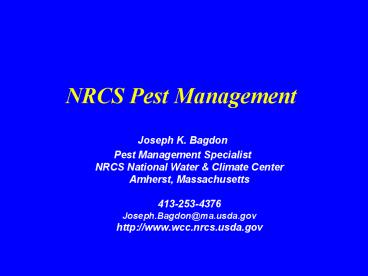NRCS Pest Management - PowerPoint PPT Presentation
1 / 24
Title:
NRCS Pest Management
Description:
Pest Management Standard (595) applies wherever pests will be managed and it ... through the vadose zone. from the edge of the field to the water body ... – PowerPoint PPT presentation
Number of Views:67
Avg rating:3.0/5.0
Title: NRCS Pest Management
1
NRCS Pest Management
- Joseph K. Bagdon
- Pest Management SpecialistNRCS National Water
Climate Center Amherst, Massachusetts413-253-43
76Joseph.Bagdon_at_ma.usda.govhttp//www.wcc.nrcs.u
sda.gov
2
3
(No Transcript)
4
NRCS Pest Management
- A component of Conservation Planning
- Pest Management Standard (595) applies wherever
pests will be managed and it requires IPM where
it is available! - More that just efficacy and economics
- RMS plans must address all pest management
related resource concerns - Farm Bill programs (EQIP and CSP) can be used to
help producers implement environmentally friendly
pest management!
5
Pest Management Componentof a Conservation Plan
- Minimum Plans and Specifications for the Pest
Management (595) Standard include - Environmental risk analysis, with approved tools
and/or procedures, for probable pest management
recommendations by crop (if applicable) and pest. - Interpretation of the environmental risk analysis
and identification of appropriate mitigation
techniques.
6
Environmental Risk Analysis
- Pest Management
- Biological control risks
- Cultural control risks
- Soil quality aspects of tillage for weed control
- evaluate with RUSLE 2, WEQ, SCI
- Pesticide control risks
- Air quality
- Air Quality Technical Note - drift and
volatilization - Water quality
- evaluate with Windows Pesticide Screening Tool
7
Environmental Risk Analysis
- Windows Pesticide Screening Tool
- WIN-PST is used to evaluate
- site-specific soils
- probable pesticide recommendations
- WIN-PST provides
- Soil/Pesticide Loss Ratings
- the potential to move offsite
- Soil/Pesticide Hazard Ratings
- offsite movement potential combined with exposure
adjusted toxicity rating
8
(No Transcript)
9
Environmental Risk Analysis
- WIN-PST only provides risk estimates for
pesticide losses in water that moves - beyond the edge of the field
- below the bottom of the root zone
10
Environmental Risk Analysis
- Conservation planners must also address
- distance to identified water resources
- flow path characteristics
- through the vadose zone
- from the edge of the field to the water body
- characteristics of the watershed
- characteristics of the waterbody
11
Environmental Risk Analysis
- Conservation planners must identify specific
resource concerns and what level of treatment
will be needed - Ground Water?
- Human drinking water and/or fish habitat?
- Surface Water?
- Human drinking water and/or fish habitat?
- Solution and/or adsorbed losses impacting aquatic
species?
12
Mitigating Pesticide Environmental Risk
- Mitigation
- The process of minimizing the potential for
harmful impacts of pest management activities on
soil, water, air, plant, and animal resources
through the application of conservation practices
and/or management techniques. - Mitigation Techniques
- Management Techniques
- Pesticide application method, rate and timing,
etc. - Conservation Practices
- Residue Management, Filter Strip, Irrigation
Water Management, etc.
13
Basic Mitigation Categories
- Reduce quantity of pesticide applied
- Utilize less hazardous pesticides
- Prevent pesticide from moving away from its point
of efficacy (in field) - Prevent pesticide from leaving the field (bottom
of root zone - edge of field)
14
Appropriate Mitigation Techniques
- Mitigation Effectiveness Guide -Reducing
Pesticide Impacts on Water Quality - Management Techniques (9 categories)
- Conservation Practices (74 practices)
- In the field
- At the edge of the field
- Relative effectiveness by pesticide loss pathway
- ltblankgt is no effect
- or - slight effect on the resource (up to 15
change) - or -- moderate effect on the resource (up to
25) - or --- is significant effect on the resource
(up to 50)
15
(No Transcript)
16
Appropriate Mitigation Techniques
- IPM helps mitigate environmental risks!
- IPM (where available) is required by our standard
- Prevention
- Avoidance
- Monitoring
- Suppression
- But alternatives must be evaluated for
- Economics,
- Efficacy, and
- Environmental risks!
17
Partnerships
- We cannot succeed alone. We need to develop and
maintain close ties with - Extension
- Crop Consultants
- State Agricultural Agencies
- Commodity Groups
- Agrichemical Dealers
- and anyone else who influences pest management
recommendations...
18
Partnerships
- Others focus on Efficacy and Economics.
- NRCS focuses on Environmental Risk and
appropriate mitigation strategies. - Efficacy, Economics and Environmental Risk must
all be integrated in the pest management decision
making process. - Farm Bill programs can provide incentives for
implementing reduced risk alternatives. - Need to work together!
19
What about Technical Service Providers?
- TSPs must be able to do the work of an NRCS
conservation planner. - TSPs may also cover efficacy and economics,
however, this information can come from other
sources as well - note that this is not the
primary reason for TSPs. - NRCS Conservation Planners typically get efficacy
and economics information for their conservation
plans from other sources, primarily Extension.
20
Implementing Pest Management
- The scope of NRCS pest management activities will
vary widely across the country - Variance based on
- natural resource needs
- state or local regulations
- agency resources
- relationships with partners - opportunity
21
(No Transcript)
22
(No Transcript)
23
NRCS Pest Management is
- Evaluating site-specific environmental risks
- Including appropriate mitigation in the
conservation plan based on Field Office Technical
Guide (FOTG) quality criteria - Fully utilizing IPM!
- prevention
- avoidance
- monitoring
- suppression
24
For More Information
- USDA-NRCS National Water Climate Center
- www.wcc.nrcs.usda.gov
- Water Quality
- Pest Management
- NRCS Pest Management Policy
- WIN-PST Windows Pesticide Screening Tool
- NAPRA National Agricultural Pesticide Risk
Analysis - NWCC Core 4 Pest Management
- NEDC Pest Management Course Materials
- Links
- Integrated Pest Management
- Pesticide Data
- Soils Data































